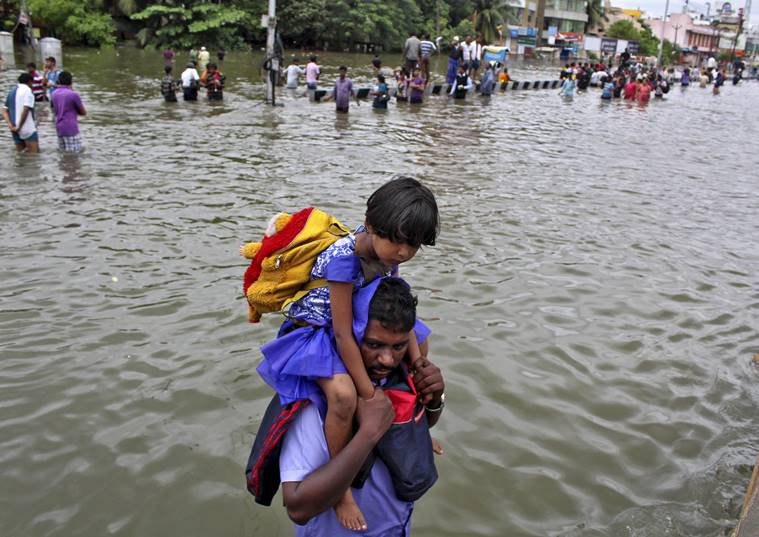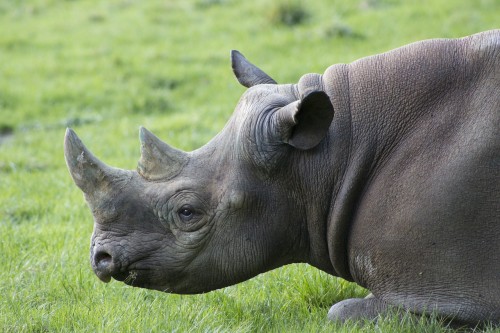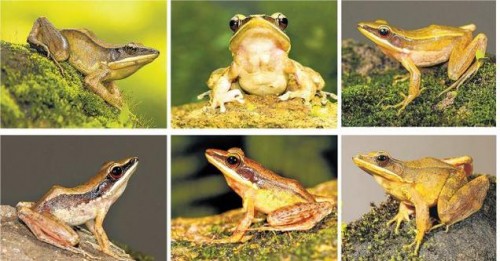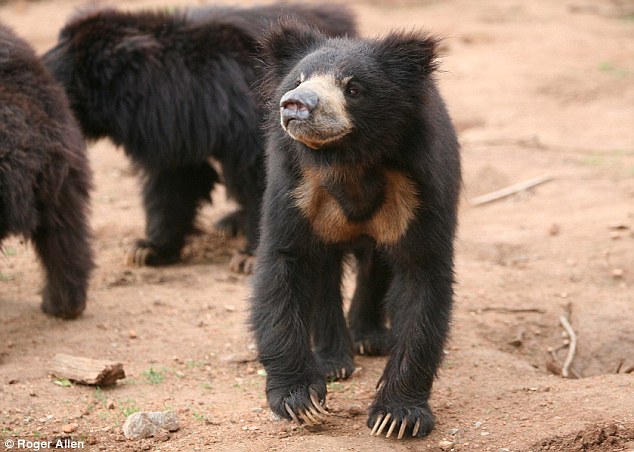“When this flood blocks the road, I am worried more by my soil getting washed, than by getting late, to reach my destination,” wrote Nepalese poet Suman Pokhrel.
For India, no words could be truer for the year 2015. If something has blocked the road of India’s savvy future in the last year, it has been the constant news of flood in some or other part of the country. From the flash floods of Gujarat to the annual flooding of the North East to the recent disasters in Tamil Nadu, rising waters have set the alarm bells ringing all through the year, breaking the pace of growth the nation has so enthusiastically embraced.

Chennai floods of December 2015, Image via IndianExpress
In retrospect, it is hard to see these calamities as individual occurrences or even natural. The extreme weather events such as the one in Chennai, Manipur, Assam or Gir National Park earlier this year are sprouting from a single event of atmosphere heating which is man-made and expanding into a bigger catastrophe each day. In 2012, it was Haiti and the Philippines that were affected, and a super-cyclone hit the Philippines again in 2013. This year, it is India’s turn.
State of the wild cats
In the July flash floods of Gujarat, 10 Asiatic lions lost their lives apart from a number of other wild animals of the Gir forests. Although the Supreme Court of India had earlier allowed the relocation of few of the Asiatic lions from Gir to another protected area in Madhya Pradesh, the plans are yet to be materialised. Till then, Gir remains the last bastion of the Asiatic lions — all of them living in one habitat, all equally vulnerable to any calamity that may arise in future.

10 Asiatic Lions drowned in the Gujarat floods of 2015. Image via VishwaGujarat
While the lions of India have been restricted to the forests of Gujarat, it was another smart cat that surprised researchers with the ease with which it has made urban India its home. An international study of radio-collared leopards in India found that the animals were not strays that had wandered out of the forest, but residents of cities, just like a cat or a dog staying in a locality. Given their extremely flexible nature, leopards have now found it a survival necessity to shift from forests to urban places, as green covers see depletion. And they also know how to remain hidden in the human jungle, avoiding contact and the conflict that may arise due to chance encounters.
For India’s national animal, the year 2015 brought reassurance that the conservation efforts are being put in the right direction. According to the latest census, India now has 2,226 tigers in the wild, showing a sharp 30 per cent increase in population from the last census done in 2010. Despite the day-to-day challenges of habitat loss, human-animal conflict and poaching, the tiger seems to be slowly, but steadily regaining its lost status as the king of the Indian jungles. What is still sad though is the rampant killings of animals including the tiger.
The Hunted
Till the mid of November this year, 22 tigers were documented to have been killed by poachers. As many as 216 leopards, 40 tigers, 43 rhinos, 100 elephants and innumerable birds and reptiles have lost their lives to the poacher’s gun in the last 18 months.
Ironically, the promise of recruiting a rhino protection force in Assam that was made in January this year, still remains in papers. Another Indian star caught in the wildlife trade is the beautiful and rare star tortoise. In a study published in the journal Nature Conservation, researchers warned of a large-scale network, fuelled by growing international demand for exotic pets, which is causing extreme suffering to the animals and threatening the survival of the species. In one site alone, at least 55,000 tortoises were poached from the wild in one year.
Hope And Innovation
Some of the frog species discovered in Western Ghats in 2015
On the positive side, India is one of the few megadiverse nations in the world, where species discoveries are still a constant delight. Adding to the growing list of species found in the rich North East, Western Ghats and the Himalayan region were a number of creatures like a newly discovered wasp, frogs, butterflies and fish. The Botanical Survey of India (BSI) and the Zoological Survey of India (ZSI) released a list of 349 new species of flora and fauna in the past one year on the World Environment Day. This includes 173 species and genera of plants and 176 species of animals.
Good news also came in the form of another survey result that showed that the country’s forest cover has grown 3,775 sq km since 2013, taking the total to 7,01,673 sq km — 21.34 per cent of the country’s geographical area. Experts do worry though that the increase of cover isn’t the indicator of the protection or growth in numbers of local plant species that are more vital to the sustenance of the local habitats than afforestation alone.

Ganges Dolphin, Image via WWF
A survey of the Ganges river dolphins revealed 1,263 dolphins in Uttar Pradesh against 671 in the 2012 census. The survey also counted 116 dolphins in a 215-km stretch of the river from Lakshagrah in Allahabad to Kaithi in Varanasi, a confluence of Ganga and Gomti. If these numbers are to be believed, the national aquatic animal is faring well despite the high level pollution of River Ganga.
Local community power proved its mettle once again in 2015 where aware citizens chose to conserve, protect and nurture, while they led a sustainable life and prospered too. The Nyishi tribe of Nagaland, once hunters of the famed great hornbill of the state have now become protectors of the bird and its future generations, by guarding their nests. It’s a prime example of how given the correct knowledge, locals can be the greatest asset in fighting the conservation battle.
John Muir once said, “When we try to pick out anything by itself, we find it hitched to everything else in the universe.” Let us hope in 2016, the opportunities to help the crippled planet back on its foot are much more than the deliberate attempts to hurt it further. Development without ecological stability can only make calamities such as the floods, a routine than a rarity.
This is re-published from an original article that appeared in Deccan Herald’s Spectrum Environment supplement on 29 Dec, 2015 under the heading An environmental round up written by Atula Gupta. Read it here.
More Related Stories,
Endangered Asiatic Lions Drown in Flash Floods
India’s Tiger Numbers Rise to 2226
New Species of Golden Backed Frog Discovered
Leopards Prefer To Live Near Human Habitats







